0-front-matter[1].pdf
Computational Ocean Acoustics
Series Preface
Preface to the Second Edition
Preface to the First Edition
Contents
1-Fundamentals of Ocean Acoustics.pdf
Chapter 1 Fundamentals of Ocean Acoustics
1.1 Introduction
1.2 The Ocean-Acoustic Environment
1.3 Some Acoustic Preliminaries
1.3.1 Sources and Receivers
1.3.2 Energy, Power and Intensity
1.3.2.1 Energy
1.3.2.2 Power and Intensity
1.3.2.3 Complex Notation and Intensity
1.3.3 Relevant Units
1.3.3.1 Intensity and Decibels
1.3.3.2 Spectrum Level
1.3.4 Transmission Loss
1.4 Sound Propagation in the Ocean
1.4.1 Characteristic Propagation Paths
1.4.2 Deep Water
1.4.2.1 Nearfield Lloyd-Mirror Pattern
1.4.2.2 Convergence-Zone Propagation
1.4.2.3 Deep-Sound-Channel Propagation
1.4.2.4 Surface-Duct Propagation
1.4.2.5 Arctic Propagation
1.4.3 Shallow Water
1.4.4 Range-Dependent Environments
1.4.4.1 An Ocean Front
1.4.4.2 A Seamount
1.5 Volume Attenuation
1.5.1 Attenuation of Plane Waves
1.5.2 Attenuation in Seawater
1.6 Bottom Loss
1.6.1 Fluid--Fluid Interface
1.6.2 Fluid--Solid Interface
1.6.3 Layered Fluid Halfspace
1.6.3.1 Quarter-Wavelength Layer
1.6.3.2 Half-Wavelength Layer
1.6.4 Arbitrary Layering
1.7 Boundary and Volume Scattering
1.7.1 Surface Scattering
1.7.2 Bottom Scattering
1.7.3 Volume Scattering
1.8 Ambient Noise
1.9 Sound Propagation Models
Problems
References
2-Wave Propagation Theory.pdf
Chapter 2 Wave Propagation Theory
2.1 The Wave Equation
2.1.1 The Nonlinear Wave Equation
2.1.2 The Linear Wave Equation
2.1.2.1 Wave Equation for Pressure
2.1.2.2 Wave Equation for Particle Velocity
2.1.2.3 Wave Equation for Velocity Potential
2.1.2.4 Wave Equation for Displacement Potential
2.1.2.5 Source Representation
2.1.2.6 Solution of the Wave Equation
2.2 The Helmholtz Equation
2.3 Homogeneous Media
2.3.1 Coordinate Systems
2.3.2 Source in Unbounded Medium
2.3.3 Source in Bounded Medium
2.3.4 Point Source in Fluid Halfspace
2.3.5 Transmission Loss
2.4 Layered Media and Waveguides
2.4.1 Integral Transform Techniques
2.4.1.1 Plane Propagation Problems
2.4.1.2 Axisymmetric Propagation Problems
2.4.2 Source in Fluid Halfspace
2.4.3 Reflection and Transmission
2.4.3.1 Hard Bottom
2.4.3.2 Soft Bottom
2.4.3.3 The Point Source Field
2.4.4 Ideal Fluid Waveguide
2.4.4.1 Image Method
2.4.4.2 Integral Transform Solution
2.4.4.3 Normal Modes
2.4.4.4 Modal Dispersion
2.4.4.5 The Waveguide Field
2.4.4.6 Relationship Between Image and Modal Solutions
2.4.5 The Pekeris Waveguide
2.4.5.1 Normal Modes
2.4.5.2 Modal Dispersion
2.4.5.3 The Waveguide Field
2.4.5.4 Reciprocity
2.4.5.5 Attenuation
2.4.5.6 General Waveguide Image Solution
2.4.6 Waveguide Invariants
2.4.6.1 Frequency--Range Waveguide Invariant
2.4.6.2 Generalized Waveguide Invariant
2.5 Deep-Ocean Waveguides
2.5.1 Exact Solutions
2.5.2 WKB Solutions
Appendix 1: Principle of Reciprocity
Problems
References
3-Ray Methods.pdf
Chapter 3 Ray Methods
3.1 Introduction
3.2 Ray Bending
3.3 Mathematical Derivation
3.3.1 Solving the Eikonal Equation
3.3.2 Solving the Transport Equation
3.3.3 Ray Amplitudes and Jacobians
3.3.4 Initial Conditions
3.3.5 Intensity Calculations
3.3.5.1 Dynamic Ray Tracing
3.3.5.2 Coherent Transmission Loss
3.3.5.3 Incoherent Transmission Loss
3.3.5.4 Semicoherent Transmission Loss
3.3.5.5 Geometric Beams
3.4 Ray Anomalies
3.4.1 Caustics and Shadow Zones
3.4.2 Region of Validity of the Ray Solution
3.5 Gaussian Beams
3.5.1 Gaussian Beams in Free Space
3.5.2 Gaussian Beam Tracing
3.6 Additional Mathematical Properties
3.6.1 Alternate Forms of the Ray Equations
3.6.1.1 -Form
3.6.1.2 z(r) and r(z) Forms
3.6.2 Treatment of Attenuation
3.6.3 Interfaces and Boundaries
3.6.4 Weak Interfaces and Ocean Sound-Speed Discontinuities
3.6.5 Fermat's Principle
3.6.6 Simplifications for Stratified Media
3.6.7 Snell's Law
3.6.8 Reciprocity
3.7 Numerical Solution
3.7.1 Direct Integration
3.7.1.1 Tracing the Rays
3.7.1.2 Boundary Reflections
3.7.1.3 Intensity Calculations
3.7.2 Cell Methods: n2 Linear
3.7.3 Cell Methods: c Linear
3.7.4 False Caustics and Profile Interpolation
3.7.5 Finding Eigenrays
3.7.5.1 Interpolation
3.7.5.2 Iteration
3.7.5.3 The Bending Method
3.7.5.4 The Continuation Method
3.8 Extensions and Related Techniques
3.8.1 The WKB Method
3.8.2 Ray Theory via the WKB Approximation
3.8.3 The Ray Invariant and the Waveguide Invariant
3.8.3.1 Example 1: Ideal Waveguide
3.8.3.2 Example 2: n2-Linear Refracting Waveguide
3.8.4 Hamiltonian Formulation of Ray Acoustics
3.8.5 Three-Dimensional Ray Tracing
Appendix 1: Recipe for Simple Ray Code
Appendix 2: A Useful Property of the Jacobian
Problems
References
4-Wavenumber Integration Techniques.pdf
Chapter 4 Wavenumber Integration Techniques
4.1 Introduction
4.2 Mathematical Derivation
4.2.1 Integral Transform Solution
4.2.2 Homogeneous Fluid Layers
4.2.3 n2-Linear Fluid Layers
4.2.4 Homogeneous Elastic Layers
4.2.5 Boundary Conditions
4.2.6 Attenuation
4.3 Numerical Solution of the Depth Equation
4.3.1 Direct Global Matrix Approach
4.3.1.1 Numerical Stability
4.3.1.2 Advantages and Disadvantages
4.3.2 Propagator Matrix Approach
4.3.2.1 Numerical Stability
4.3.2.2 Advantages and Disadvantages
4.3.3 Invariant Embedding Approach
4.3.3.1 Numerical Stability
4.3.3.2 Advantages and Disadvantages
4.4 Reflection Coefficients
4.5 Wavenumber Integration
4.5.1 Fast Field Approximation
4.5.2 Truncation of Integration Interval
4.5.3 Wavenumber Discretization: Aliasing
4.5.4 FFP: Fast Field Program
4.5.5 Complex Contour Integration
4.5.6 Fast Hankel Transforms
4.5.7 Trapezoidal Rule Integration
4.5.8 Filon Integration
4.5.9 Adaptive Integration
4.6 Frequency Integration
4.7 Range-Dependent Propagation
4.8 3-D Wavenumber Integration
4.9 Scattering and Reverberation in a Stratified Ocean
4.9.1 Target Scattering
4.9.2 Rough Interface Reverberation
4.9.2.1 Wavenumber Representation
4.9.2.2 Finite Roughness Patch
4.9.3 Scattering from Volume Inhomogeneities
4.9.3.1 Monostatic Backscatter
4.10 Numerical Examples
4.10.1 Waveguide with an Elastic Bottom
4.10.2 The Bucker Waveguide
4.10.3 Beam Reflection and Transmission
4.10.4 Arctic Propagation
4.10.5 Seabed Target Scattering and Reverberation
4.10.5.1 Reverberant Field
4.10.5.2 Target Scattering
4.10.6 Reverberation from Seabed Volume Inhomogeneities
4.10.6.1 Fast Sediment Layer with Volume Inhomogeneities
4.10.6.2 Upward Refracting Sediment Layer
Appendix 1: Recipe for Simple WI/FFP Code
Appendix 2: Roughness Perturbation Operators
Problems
References
5-Normal Modes.pdf
Chapter 5 Normal Modes
5.1 Introduction
5.2 Mathematical Derivation
5.2.1 Point Source in Cylindrical Geometry
5.2.2 Line Source in Plane Geometry
5.3 Modal Expansion of the Green's Function
5.4 The Isovelocity Problem
5.5 A Generalized Derivation
5.6 A Deep Water Problem: The Munk Profile
5.7 Numerical Approaches
5.7.1 Finite-Difference Methods
5.7.1.1 Sturm's Method
5.7.1.2 Inverse Iteration
5.7.1.3 Richardson Extrapolation
5.7.1.4 Treatment of Interfaces
5.7.1.5 Mode Normalization
5.7.2 Layer Methods
5.7.3 Shooting Methods
5.7.4 Root Finders
5.7.4.1 Bisection
5.7.4.2 Deflation
5.7.4.3 Brute-Force Search
5.7.4.4 Analytic Estimates
5.7.4.5 Continuation Methods
5.7.4.6 Approaches Unique to the Complex Plane
5.7.5 Choice of Numerical Algorithm
5.8 Prüfer Transformations and Mode Counting
5.8.1 Top Halfspaces
5.8.2 Bottom Halfspaces
5.9 Modal Perturbation Theory
5.9.1 Modal Propagation Loss
5.9.2 Modal Group Velocity
5.10 Elastic Media
5.10.1 Governing Equations
5.10.2 Numerical Discretization
5.10.3 Shooting Methods and Compound Matrices
5.10.4 Boundary and Interface Conditions
5.10.4.1 Perfectly Free Boundary (Dirichlet BC)
5.10.4.2 Perfectly Rigid Boundary (Neumann BC)
5.10.4.3 Acoustic Halfspace Conditions (Robin BC)
5.10.4.4 Elastic Halfspace Conditions
5.10.5 Numerical Example
5.11 Normal Modes for Range-Dependent Environments
5.11.1 Coupled Modes
5.11.2 One-Way Coupled Modes
5.11.3 The Adiabatic Approximation
5.11.4 Example: A Warm-Core Eddy
5.12 Scattering from Objects in a Waveguide
5.12.1 Scattering Geometry
5.12.2 The Plane-Wave Scattering Function
5.12.3 Scattering from Spherical Objects in a Waveguide
5.12.4 Scattering from Non-Spherical Objects
5.13 Normal Modes for 3-D Varying Environments
5.13.1 Horizontal Refraction Equations
5.13.2 Global Propagation
5.13.3 3-D Mode Coupling Around Seamounts
5.13.3.1 Mathematical Formulation
5.13.3.2 Spectral Coupled-Mode Solution
5.13.3.3 Azimuthally Scattered Mode Amplitudes
5.14 Waveguide Invariant and Dispersion for Realistic Environments
5.14.1 The Waveguide Invariant Is Variable!
5.14.2 Range-Dependent Group Speed and Adiabatic Mode Theory
5.14.3 Waveguide Invariant for Range-Dependent Environments
Appendix 1: Recipe for Simple Mode Code
Appendix 2: Evaluation of the Normalization Term
Problems
References
6-Parabolic Equations.pdf
Chapter 6 Parabolic Equations
6.1 Introduction
6.2 Derivation of Parabolic Equations
6.2.1 Standard PE Derivation
6.2.2 Generalized PE Derivation
6.2.3 Expansion of the Square-Root Operator
6.2.4 Phase Errors and Angular Limitations
6.3 The Elastic PE
6.4 Starting Fields
6.4.1 Numerical Starters
6.4.1.1 Modal Starter
6.4.1.2 PE Self Starter
6.4.2 Analytical Starters
6.4.2.1 Gaussian Source
6.4.2.2 Greene's Source
6.4.2.3 Thomson's Source
6.4.2.4 Generalized Gaussian Source
6.4.3 Spectral Properties of Sources
6.5 Solutions by FFTs
6.5.1 The Split-Step Fourier Algorithm
6.5.2 Error Analysis
6.5.3 Numerical Implementation
6.5.4 Variable Density
6.5.5 Attenuation
6.6 Solutions by FDs and FEs
6.6.1 Field Equations on Horizontal Interfaces
6.6.2 IFD Formulation
6.6.3 Error Analysis
6.6.4 Numerical Implementation
6.7 The Problem of Energy Conservation in PEs
6.8 Three-Dimensional PEs
6.8.1 Expansion of the Square-Root Operator
6.9 Numerical Examples
6.9.1 Beam Propagation
6.9.1.1 Beam Splitting
6.9.1.2 Beam Reflection and Transmission
6.9.1.3 Beam Focusing
6.9.2 Propagation in a 2-D Wedge
6.9.3 Propagation Over a Seamount
6.9.4 Propagation Over a Sloping Elastic Bottom
6.9.5 Propagation in a 3-D Wedge
Appendix 1: Recipe for Simple PE Code
Problems
References
7-Finite Differences and Finite Elements.pdf
Chapter 7 Finite Differences and Finite Elements
7.1 Introduction
7.2 Differential Equations
7.3 Finite-Difference Methods
7.3.1 Introduction
7.3.2 Difference Approximations
7.3.3 Convergence and Stability
7.3.4 The Wave Equation
7.3.4.1 Finite-Difference Scheme
7.3.4.2 Source Representation
7.3.4.3 Boundary and Radiation Conditions
7.4 Finite-Element Methods
7.4.1 Introduction
7.4.2 Mathematical Derivation
7.4.2.1 Weighted Residuals
7.4.2.2 Variational Principle
7.4.2.3 The FEM Equations
7.4.2.4 Trial Functions
7.4.2.5 Partial Discretization
7.4.3 The Acoustic Wave Equation
7.4.3.1 Galerkin Approaches
7.4.3.2 Finite Elements
7.4.3.3 Finite Elements in Two and Three Dimensions
7.4.3.4 Boundary and Radiation Conditions
7.4.4 The Elastic Wave Equation
7.4.5 Coupled Fluid--Elastic Domains
7.4.6 Steady-State Solutions
7.4.7 Perfectly Matched Layers
7.4.8 Time Recurrence
7.5 Boundary-Element Methods
7.5.1 Introduction
7.5.2 The Boundary-Integral Equation
7.5.3 Boundary-Element Equations
7.5.3.1 Trial and Weight Functions
7.5.4 Coupled Domains
7.5.4.1 Interior Boundary-Element Solution
7.5.4.2 Interior Finite-Element Solution
7.5.5 Virtual Source Concept
7.5.5.1 Green's Functions
7.5.5.2 Numerical Implementation Issues
7.6 Numerical Examples
7.6.1 Scattering by Arctic Ice Features
7.6.1.1 Finite-Difference Solution
7.6.1.2 Boundary-Element Solution
7.6.2 Scattering from Objects Near Interfaces
7.6.2.1 Filled Spherical Shell on the Seabed
7.6.2.2 Buried, Filled Spherical Shell
7.6.2.3 Half-Buried, Filled Spherical Shell
Appendix 1: Variational Formulation for Fluid--Elastic Interaction
Appendix 2: Farfield Computations
Problems
References
8-Broadband Modeling.pdf
Chapter 8 Broadband Modeling
8.1 Introduction
8.2 Fourier Synthesis of Frequency-Domain Solutions
8.2.1 Evaluation by FFT
8.2.1.1 Frequency Windowing
8.2.1.2 Fast Fourier Transforms
8.2.1.3 Time Windowing and Sampling
8.2.2 Complex Frequency Integration
8.3 Time-Domain Solutions
8.3.1 Ray Methods
8.3.2 Spectral Integral Techniques
8.3.3 Parabolic Equations
8.4 Doppler Shift in a Waveguide
8.4.1 Wavenumber Integral Representation
8.4.2 Normal Mode Representation
8.4.3 Doppler Shift for Active Sonar
8.5 Numerical Examples
8.5.1 The Head-Wave Problem
8.5.2 Mode Dispersion in a Waveguide
8.5.3 3-D Wedge Propagation
8.5.4 Seismic Interface Waves
8.5.5 Deep-Water Propagation
8.5.6 Surface-Duct Propagation with Leakage
8.5.7 Acoustic Emission from Ice Fractures
Problems
References
9-Ambient Noise.pdf
Chapter 9 Ambient Noise
9.1 Introduction
9.2 Surface Noise in a Stratified Ocean
9.2.1 Mathematical Derivation
9.2.2 Spatial Distribution of Noise Sources
9.2.3 Wavenumber Integral Representation
9.2.4 Normal Mode Representation
9.2.5 Noise in a Homogeneous Halfspace
9.2.6 Noise in Stratified Media
9.2.6.1 Fluid Waveguide
9.2.6.2 Elastic Waveguide
9.3 Extracting Time-Domain Green's Functions from Noise Correlation Functions
9.3.1 The Time-Domain Green's Function
9.3.2 Emergence of Coherent Wavefronts from Noise
9.3.3 Data Examples of Extracting Wavefronts from Noise
9.4 Surface Noise in a Three-Dimensional Ocean
9.4.1 Noise Modeling by Adiabatic Modes
9.4.2 Simulated Noise Fields in 3-D Environments
9.4.2.1 ``Image'' of Noise Levels
9.4.2.2 Noise Directionality
9.4.3 Noise Modeling by PE
9.4.4 Downslope and Deep-Ocean-Basin Noise Field
Appendix 1: Evaluation of the Cross-Spectral Density
Problems
References
10-signal in noise.pdf
Chapter 10 Signals in Noise
10.1 Introduction
10.2 The Energetics of Signals in Noise
10.2.1 Array Gain
10.2.2 Sonar Equation
10.2.2.1 Detection Threshold and ROC Curves
10.2.2.2 Passive Sonar Equation
10.2.2.3 Active Sonar Equation
10.3 Plane-Wave Beamforming
10.3.1 Linear Beamforming
10.3.2 Adaptive Beamforming
10.3.2.1 Estimating the Cross-Spectral Density Matrix
10.3.2.2 Minimum Variance Distortionless Processor
10.3.2.3 Eigenvector Beamformers
10.3.3 Multiple-Constraints Beamforming
10.3.4 White-Noise Constraint Processor
10.3.4.1 Derivation of the White-Noise Constraint Processor
10.4 Time-Domain Processing
10.4.1 Isovelocity Time-Delay Beamforming
10.4.2 Non-Isovelocity Time-Delay Beamforming: The Turning Point Filter
10.4.3 Example: Passive Fathometer
10.5 Performance Prediction: Modeling, Beamforming and the Sonar Equation
10.6 Matched-Field Processing
10.7 Simulating Matched-Field Processing
10.7.1 Depth--Range Matched Field Processing
10.7.1.1 Shallow-Water Simulation
10.7.1.2 Deep-Water Arctic Simulation
10.7.2 Three-Dimensional Matched Field Processing
10.7.2.1 2-D Ambiguity Surface for 3-D Problem
10.7.2.2 3-D Ambiguity Function
10.7.2.3 Broadband Matched-Field Processing
10.8 Vector-Sensor Beamforming
10.9 Synthetic Signals and Sensor Stimulation
10.9.1 Stochastic Signal and Noise Model
10.9.2 Snapshot Synthesis
10.9.3 Signal Variability
10.9.4 Noise Realizations
10.10 Phase Conjugation and Time Reversal
10.10.1 Theory and Simulation for Phase Conjugation/TRM in the Ocean
10.10.1.1 Harmonic Point Source
10.10.1.2 Pulse Excitation
10.10.1.3 Properties of the Focal Region: Modes and Images
10.10.1.4 Non-Reciprocal Time Reversal and Passive Time Reversal
10.10.1.5 Variable Range Focusing
10.10.1.6 Adaptive Phase Conjugation
10.10.1.7 Sourceless Time Reversal
10.11 Summary
Problems
References
11-back-matter.PDF
About the Authors
Name Index
Subject Index
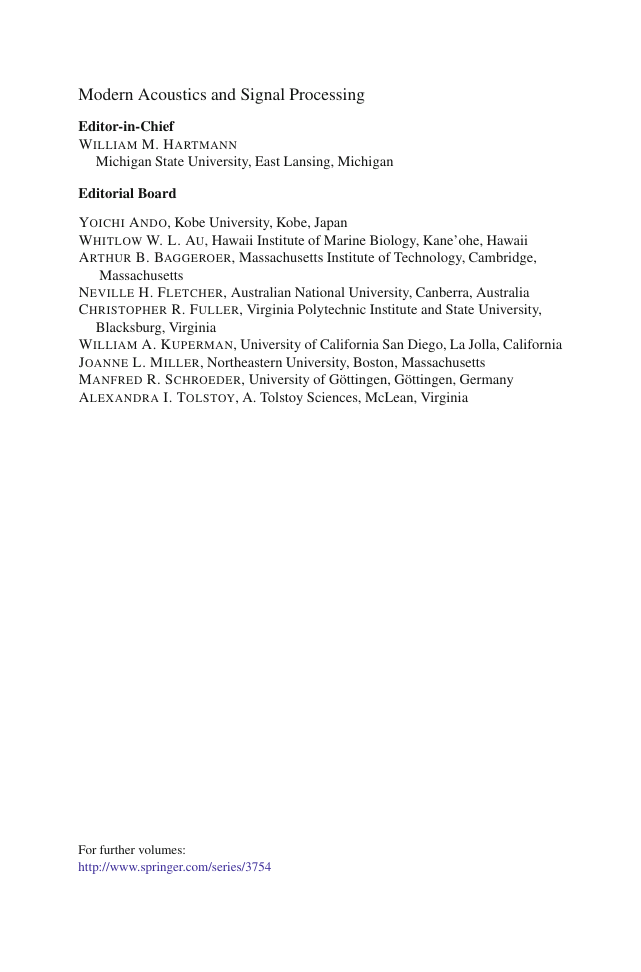

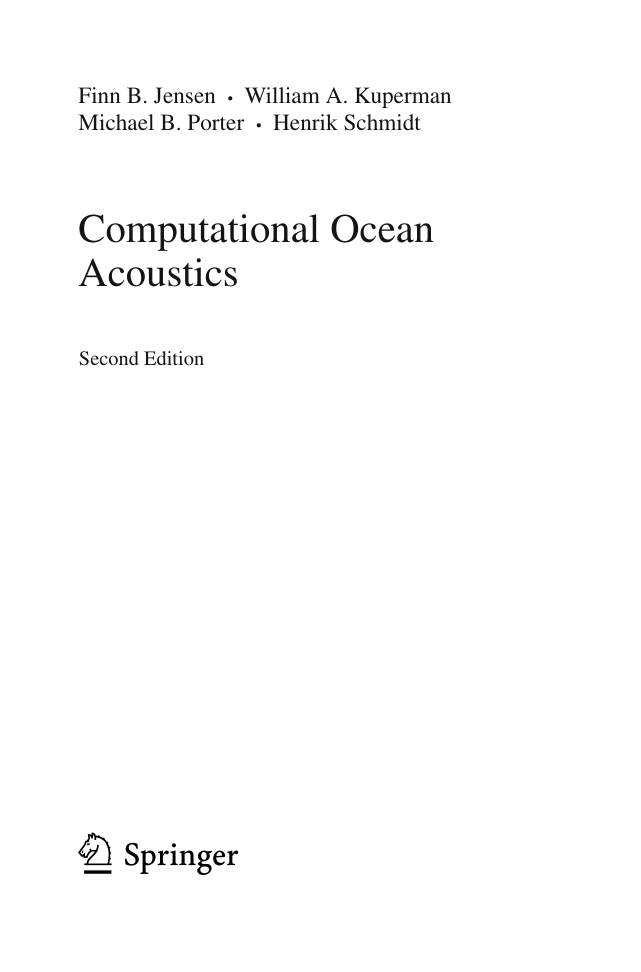

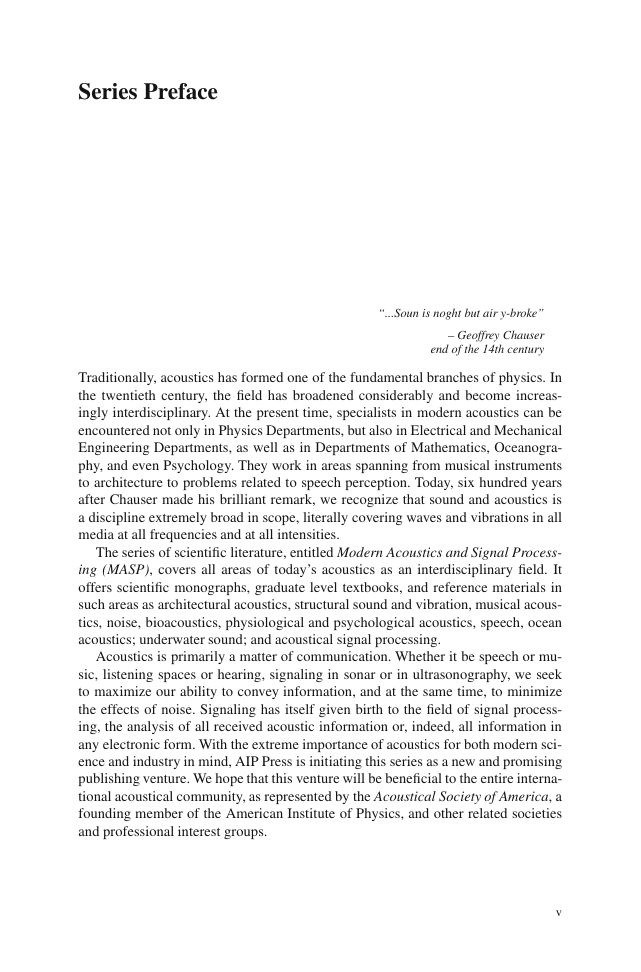

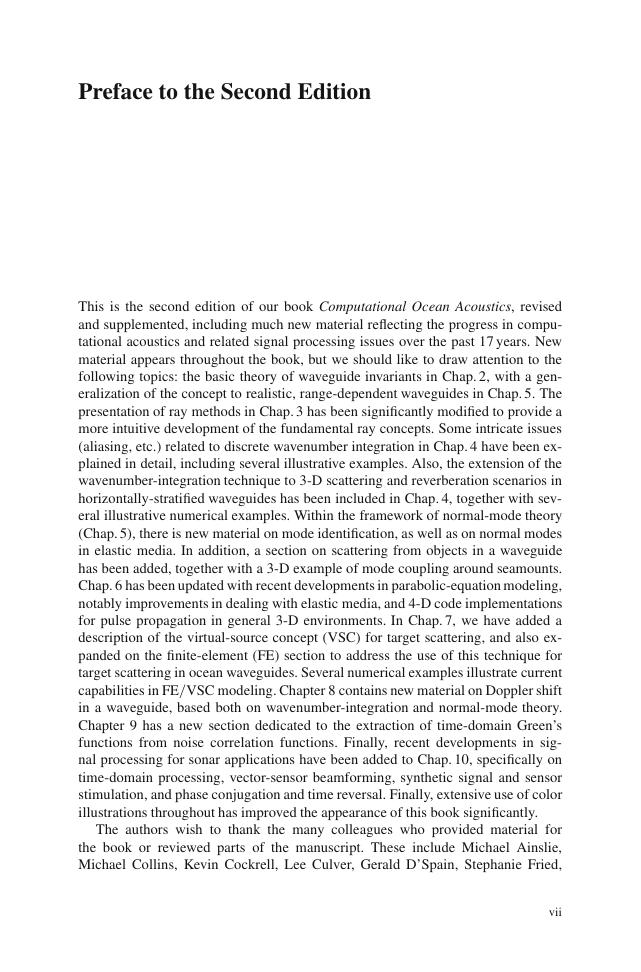
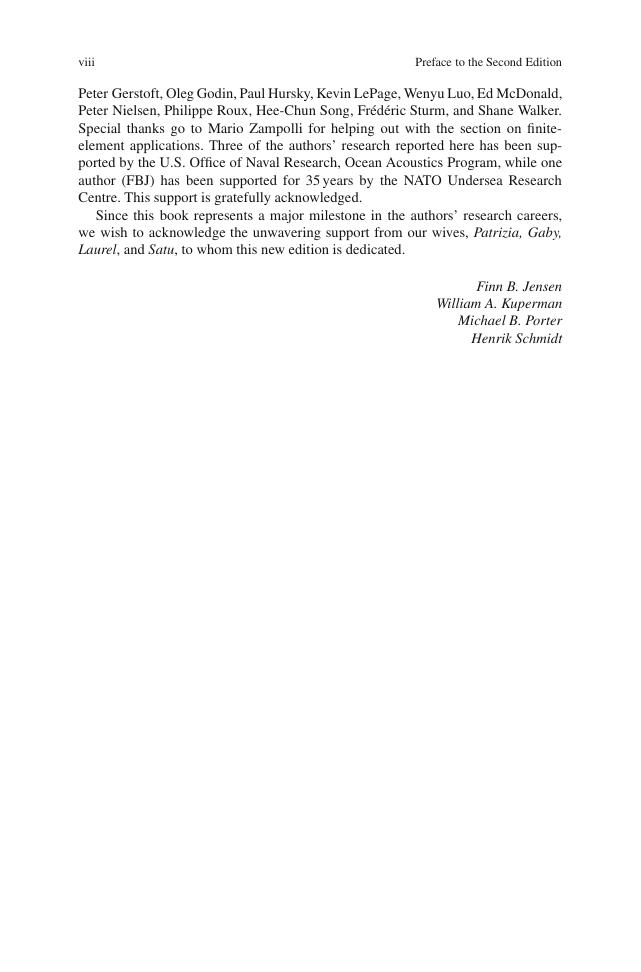








 2023年江西萍乡中考道德与法治真题及答案.doc
2023年江西萍乡中考道德与法治真题及答案.doc 2012年重庆南川中考生物真题及答案.doc
2012年重庆南川中考生物真题及答案.doc 2013年江西师范大学地理学综合及文艺理论基础考研真题.doc
2013年江西师范大学地理学综合及文艺理论基础考研真题.doc 2020年四川甘孜小升初语文真题及答案I卷.doc
2020年四川甘孜小升初语文真题及答案I卷.doc 2020年注册岩土工程师专业基础考试真题及答案.doc
2020年注册岩土工程师专业基础考试真题及答案.doc 2023-2024学年福建省厦门市九年级上学期数学月考试题及答案.doc
2023-2024学年福建省厦门市九年级上学期数学月考试题及答案.doc 2021-2022学年辽宁省沈阳市大东区九年级上学期语文期末试题及答案.doc
2021-2022学年辽宁省沈阳市大东区九年级上学期语文期末试题及答案.doc 2022-2023学年北京东城区初三第一学期物理期末试卷及答案.doc
2022-2023学年北京东城区初三第一学期物理期末试卷及答案.doc 2018上半年江西教师资格初中地理学科知识与教学能力真题及答案.doc
2018上半年江西教师资格初中地理学科知识与教学能力真题及答案.doc 2012年河北国家公务员申论考试真题及答案-省级.doc
2012年河北国家公务员申论考试真题及答案-省级.doc 2020-2021学年江苏省扬州市江都区邵樊片九年级上学期数学第一次质量检测试题及答案.doc
2020-2021学年江苏省扬州市江都区邵樊片九年级上学期数学第一次质量检测试题及答案.doc 2022下半年黑龙江教师资格证中学综合素质真题及答案.doc
2022下半年黑龙江教师资格证中学综合素质真题及答案.doc